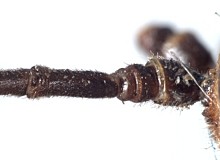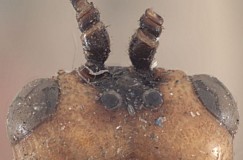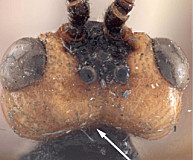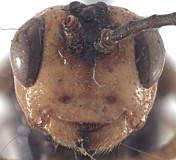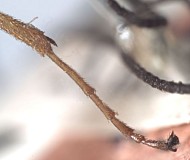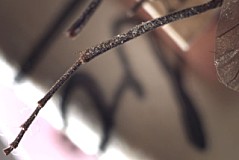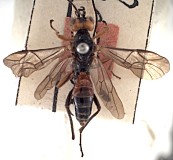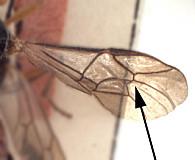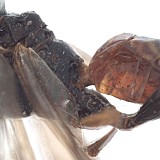First flagellomere of antenna densely setose throughout (Fig. 1); interantennal flange absent (Fig. 2), replaced by low, somewhat irregular, V or Y-shaped carina, the median stem indistinct (Fig. 3); lateral swelling of frons with weakly carinate inner margin; face finely and sparsely punctate laterally (Fig. 4), slightly more densely punctate than
W. ruficeps medially; occipital carina weak, partly obliterated (Fig. 3); male tarsus long and slender (Figs 5, 6); shape of female tarsus unknown; fore wing (Figs 7, 8) with stigma dark brown and areolet absent; fore tarsus yellow, hind tarsus dark brown, mesosoma (Figs 7, 9) black, metasoma dorsally, except for apical margin of terga, reddish basally (Fig. 9), black apically. Females are unknown and therefore sexual dimorphism in structure of the tarsi cannot be assessed.
Distinguished from all other species of Westwoodia by the poorly developed occipital carina and the absence of a fore wing areolet. This species is most similar to W. romani, based on the elongate fore and hind tarsi, setal pattern on the occiput, and sculptural details of the interantennal area and frons: specifically the absence of an elevated flange between the antennae, and the presence of low carinae. The median depression on the frons is not quite as deep and the carina along the lateral margin of the depression is not as well developed as in W. romani, but the frontal depression in both species is more shallow than it is in W. ruficeps and W. gauldi.
One specimen from Adelaide noted in the material examined section is difficult to place because it is somewhat intermediate between W. romani and W. longipes. The occipital carina is effaced dorsomedially in this specimen vs. W. romani but well-developed dorsolaterally and laterally vs. W. longipes. As in W. romani, the fore wing areolet is present in the Adelaide specimen (though small), and the frons is more distinctly impressed, with the median carina present. The dorsal tendon of the propodeum is attached to almost a flat surface on the petiole of the Adelaide specimen as it is in the holotype of W. longipes, but attaches within a distinct depression in all other specimens of Westwoodia that we have examined, including the type series of W. romani. The Adelaide specimen raises the possibility that the holotype, the only known specimen of W. longipes, is an extreme variant of the species we have described as W. romani. However, until more material becomes available to assess this possibility, it seems more logical to retain the two as separate species given the differences in wing venation. The Adelaide specimen was specifically mentioned by Morley (1913) in his redescription of W. ruficeps, which it clearly is not because of the slender tarsi and lack of a tall, median, interantennal flange.
The incomplete and weakly developed occipital carinae also serves to distinguish this species from all other described members of the tribe Westwoodiini. Roman (1915) described the occipital carina as absent above and on the temple. The carina is present though weak on the ventral part of the head, and appears to be weakly indicated dorsally, at least in part. This is difficult to verify because the holotype is somewhat dirty.
1.
Base of antenna showing setal patt...
Base of antenna showing setal pattern on first flagellomere.
↰
↴
2.
Back of head showing shallow frontal de...
Back of head showing shallow frontal depression.
↰
↴
3.
Back of head showing occipital...
Back of head showing occipital carina absent medially (arrow) and irregular carinae in frontal depression.
↰
↴
6.Right hind leg, posterior view.
8.
Right fore wing showing absenc...
Right fore wing showing absence of areolet (arrow).
↰
↴
9.
Lateral view, propodeum ...
Lateral view, propodeum and petiole.
↰
↴

